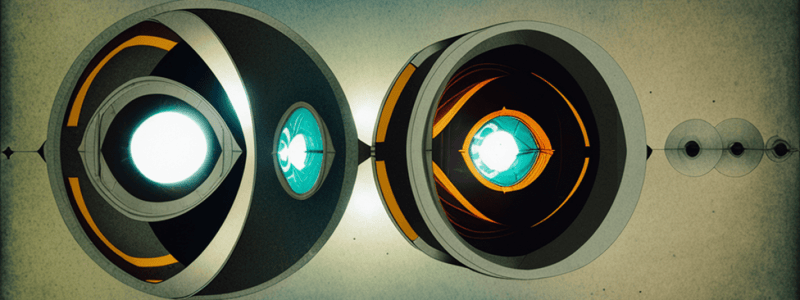Podcast
Questions and Answers
Convex lenses cause light rays to diverge to a point.
Convex lenses cause light rays to diverge to a point.
False (B)
Concave lenses are thicker in the middle than on the edges.
Concave lenses are thicker in the middle than on the edges.
False (B)
Plano-convex lenses are convex on both sides.
Plano-convex lenses are convex on both sides.
False (B)
Bi-concave lenses are concave on both sides.
Bi-concave lenses are concave on both sides.
Convex lenses are thinner in the middle than on the edges.
Convex lenses are thinner in the middle than on the edges.
Before the 1590s, simple lenses allowed high magnification.
Before the 1590s, simple lenses allowed high magnification.
Zacharias Jansen and his father built only telescopes.
Zacharias Jansen and his father built only telescopes.
Understanding the focal length of lenses was not important for combining their powers.
Understanding the focal length of lenses was not important for combining their powers.
The text mentions that simple eyeglasses were used before the 1590s.
The text mentions that simple eyeglasses were used before the 1590s.
Bi-convex lenses are flat on one side and convex on the other.
Bi-convex lenses are flat on one side and convex on the other.
Concave lenses cause light rays to converge to a point.
Concave lenses cause light rays to converge to a point.
Convex and concave lenses come in the same configurations.
Convex and concave lenses come in the same configurations.
A concavo-convex lens is also known as a positive (converging) meniscus lens.
A concavo-convex lens is also known as a positive (converging) meniscus lens.
The focal length of a lens is the distance from the lens to the focal point.
The focal length of a lens is the distance from the lens to the focal point.
A concave lens converges parallel rays to a focal point with a positive focal length.
A concave lens converges parallel rays to a focal point with a positive focal length.
A convexo-concave lens is commonly called a positive (converging) meniscus lens.
A convexo-concave lens is commonly called a positive (converging) meniscus lens.
A combined convex and concave lens is known as a negative (divergent) meniscus lens.
A combined convex and concave lens is known as a negative (divergent) meniscus lens.
Light rays traveling parallel to the optical axis of a concavo-convex lens will meet at the focal point.
Light rays traveling parallel to the optical axis of a concavo-convex lens will meet at the focal point.
The image formed by a concavo-convex lens will be inverted relative to the actual image.
The image formed by a concavo-convex lens will be inverted relative to the actual image.
A concavo-convex lens has a negative focal length and forms only virtual, smaller images.
A concavo-convex lens has a negative focal length and forms only virtual, smaller images.
The focal length of a converging lens can be determined using a plane mirror and a graphical method.
The focal length of a converging lens can be determined using a plane mirror and a graphical method.
The intercept on the 1/V axis in the graph obtained using the graphical method represents the numerical value for which 1/U = 0.
The intercept on the 1/V axis in the graph obtained using the graphical method represents the numerical value for which 1/U = 0.
The mean value of the intercepts F1 and F2 in the graphical method gives the value of focal length F.
The mean value of the intercepts F1 and F2 in the graphical method gives the value of focal length F.
The graph of 1/U against 1/V should produce a straight line through the points.
The graph of 1/U against 1/V should produce a straight line through the points.
Flashcards are hidden until you start studying
Study Notes
- Before the 1590s, simple lenses were used for limited magnification and simple eyeglasses.
- Convex lenses, thicker in the middle than on the edges, cause light rays to converge to a point.
- Concave lenses, thicker on the edges than in the middle, cause light rays to diverge.
- Convex lenses have positive focal length, forming inverted images on the opposite side of the lens.
- Concave lenses have negative focal length, forming only virtual, smaller images on the same side of the lens as the object.
- Method for determining the focal length of a convex lens using a plane mirror and a graphical method.
- Apparatus includes a converging lens, holder, plane mirror, meter scale, mounted pin (object), and screen.
- Procedure involves obtaining a rough value for the focal length, measuring distances between object, lens, and image, and repeating with different object positions.
- Theory and calculation involves the equation 1/F = 1/U + 1/V, and finding the intercepts of the graph of 1/U against 1/V to find F1 and F2, then taking the mean value of F1 and F2 to find F.
- Results include distances, intercepts, and calculated focal length values.
- Conclusion is not explicitly stated in the text.
Studying That Suits You
Use AI to generate personalized quizzes and flashcards to suit your learning preferences.




